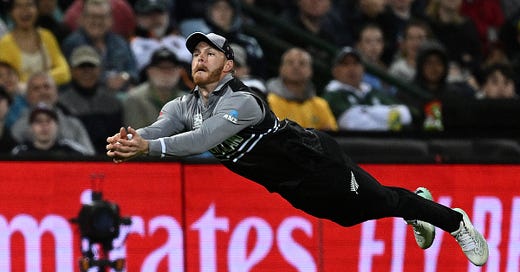LABOUR DAY SPECIAL: Where did that come from?
A mostly cricket special, with just a dash of dreaded player power (for $ subscribers).
No, you’re quite right dear reader, I did not see that coming.
This was a Black Caps team coming off patchy form, playing their bogey team, in their bogey country and losing the toss and batting first, something they have not been able to do convincingly. When Mitchell Starc was pawing the turf at the top of his mark before the first ball, I might have given New Zealand a 12.5 percent chance of winning.
Yeah, that might be ridiculous odds in a two-horse race, especially if both horses have four legs, but they are in keeping with New Zealand’s cross-format record in Australia in the past 15 years.
To remind myself as much as your good selves, this is what I wrote on Friday:
There is something masochistic about watching New Zealand play Australia at cricket in Australia. It doesn’t matter how well they’re going against every other team - and for the past year it hasn’t been that well - you know the sight of Pat Cummins et al will provoke a collective bed-wetting. Still, you have to watch and try, somehow, to find pleasure in the pain.
There might be a subconscious element of happiness insurance in there - that ability to mask the disappointment of a loss with a shoulder-shrugging “I told you so” - but most of it is rooted in genuine expectation.
Instead what we got was a T20 performance that is as close to perfection as possible, while it was Australia needing nappies as they got everything wrong from decision-making right through to execution.
By now you would have either watched it live or at the very least the highlights, so there is no need for a recap, but with the benefit of a bit of distance, here’s a half dozen notables.
1. Finn Allen made his debut 18 months ago. He has played an average of a T20I per month since then and his improvement curve has been steep even if his numbers don’t immediately suggest so. Allen is part of the first generation of back-to-front batters - those whose foundation block is hitting over the top and who then overlay that with more nuanced gap hitting, deflections and, heaven forbid, defence as they get more experienced.
When he first came into the side he was exciting and pretty ugly to watch all at the same time. There was a lot of big hitting but much of it was dragging to the leg side, falling back on the classic cow-corner hitting arc even when the ball didn’t warrant it. It was a technique that had two things written on it: “great eye-hand coordination” and “short shelf-life”.
More recently, Allen has been accessing the off side and straight boundaries. He’s still a leg-side player, but long-on was his most productive zone against Australia (20 of his 42 runs) as opposed to the arc between cow corner and fine leg (11). Bowlers will be increasingly wary of bowling too straight to him and if he can increase his effectiveness through cover, with his long levers he effectively becomes a more fearless version of peak Martin Guptill.
We should never look at Allen as a bat-for-average opener. If he ends his career hovering close to 30 that will be enough. While his current strike rate of 167 might not be sustainable - he will be increasingly analysed and play more on holding subcontinent wickets - but anything around 150 will give New Zealand an ace to hold on to.
A fitting comparison might be his opening counterpart on the weekend. David Warner has been the gold-standard T20I opener for an extended period of time. He averages 33.5 at a strike rate of 142. Warner is a better player than Allen, but New Zealand won’t mind a trade off that sees Allen play with a slightly inferior average (at the moment, at 26.9 it’s significantly inferior) and a slightly better strike rate. It will mean they have a frequent matchwinner in their team.
Keep reading with a 7-day free trial
Subscribe to The Bounce to keep reading this post and get 7 days of free access to the full post archives.




